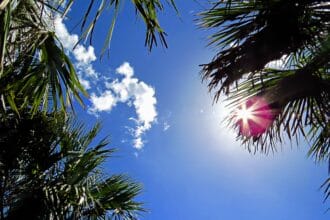FOUR YEARS AFTER THE ERUPTION

The excursion to the new volcano leaves tourists “speechless,” but hoteliers demand a strategic plan to enhance its appeal.
Tourism Recovery in La Palma
La Palma Island is beginning to regain its tourist appeal as it marks four years since the eruption of the ‘Tajogaite’ volcano. This event left an emotional and economic scar in the Valle de Aridane and destroyed over 1,200 hectares, more than 1,000 homes, and required the evacuation of over 5,000 residents over a painful 85-day period.
Even amid the COVID-19 pandemic, the volcanic gases and ash emissions led to ongoing flight cancellations and delays, severely impacting the tourism sector. The western part of the island was closed, and countless holiday rental properties were buried under lava.
Ongoing Challenges
“We are returning to a pre-volcano situation, but deep-rooted issues remain,” summarises Óscar León, president of the Centre for Initiatives and Tourism (CIT) on the island. He expresses concern that social problems—stemming from a housing crisis for affected residents and the management of volcanic gases—are damaging the destination’s image.
Statistics support the destination’s recovery, with the Meliá hotel in Puerto Naos operating at full capacity. Over the last three years, by the end of July, overnight stays on the island increased by 39.4%, with a 23.7% rise in the number of travellers, nearly a 15% increase in rates, and a 24.8% rise in revenue per room.
However, this is not enough. “Nothing has changed,” laments Carlos García, vice president and delegate of Ashotel, highlighting that neither COVID-19 nor the volcano “have altered the island’s course.” He regrets that a profitable strategy for the ‘Tajogaite’ has yet to be established.
“This is a scenic product, but it is not being fully touristically exploited by the administration. I consistently ask when we will emulate Timanfaya in La Palma, yet minimal progress has been made in this regard,” he states.
Calling for a Strategic Plan
In line with this, he stresses the need for a “strategic plan” that guides how to exploit the volcano, “taking inspiration from successful examples,” such as Lanzarote, which is “teeming with tourists.” “At this point, we are lagging behind,” he adds.
The head of the CIT echoes this sentiment, admitting that curiosity about the volcano “has diminished” since an initial surge. While it remains the most sought-after excursion by tourists, alongside La Caldera de Taburiente and Marcos y Cordero, he notes, “things are not being done correctly. It’s progressing, but slowly.”
Optimism Amidst Challenges
Raquel Rebollo, the island’s Tourism Councillor, holds a more optimistic view, requesting additional time to maximise the ‘Tajogaite’ potential. She explains that during the first year and a half, access was restricted due to high temperatures and gas emissions, hindering product development.
“It’s an excursion that leaves visitors speechless, and it is highly recommended. However, we need more signage and associated services on that route. We continue to work on professionalising this, but we must remember that it is a relatively new resource for La Palma,” she states.
To bolster tourism recovery, improved air connectivity is crucial. Some markets await increased tourist accommodation to spur the activity of tour operators and flights.
The island has over 16,000 beds, comparable to some tourist municipalities in Tenerife or Gran Canaria. While La Palma is a natural destination, more hotel beds are essential to make “designing tour packages on the island profitable,” she explains.
Connectivity Recovery
Nonetheless, she insists that connectivity recovery is evident, with 108,000 international slots available for the winter campaign.
“We are not declining; on the contrary, we are growing,” she indicates, emphasising the importance of working proactively with airlines to ensure this growth is linked with increasing hotel capacities, enabling “more profitable prices for visitors to the island.”
Carlos García questions the “monopoly” held by Iberia over national flights and the high cost of tickets. He also criticises the slow progress of new tourist complexes, like the eco-resort La Pavona, which could stimulate tour operators.
The CIT members agree with this assessment, regretting the lack of differentiated projects linked to golf or wellness tourism on an island where the banana sector believes it “cannot provide more,” yet tourism is the sector that “can drive the economy.” “What we have on the island is good, but we need more,” he remarks.
The island’s Tourism Councillor places significant emphasis on the high level of satisfaction reported by visitors, noting that the destination is “cheaper” than many others, showcasing extensive natural attractions, excellent cuisine, and good service.
“Once people get to know us, their satisfaction level is very high, and they recommend us,” she highlights.














